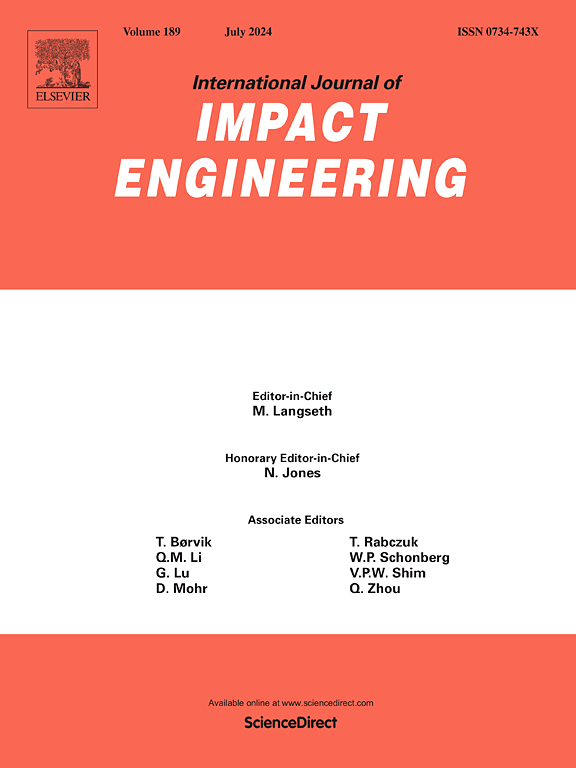Random phase field model for simulating mixed fracture modes in spatially variable rocks under impact loading
IF 5.1
2区 工程技术
Q1 ENGINEERING, MECHANICAL
International Journal of Impact Engineering
Pub Date : 2024-11-16
DOI:10.1016/j.ijimpeng.2024.105174
引用次数: 0
Abstract
A novel rigorous random phase field model, capable of simulating mixed fracture modes in spatially heterogeneous rocks under impact loading, is proposed. By treating the critical energy release rate as a function dependent on spatial coordinates, a new energy functional is constructed. A governing equation distinct from that used in phase field models addressing dynamic fractures of homogeneous materials is derived using the variational principle. The driving force is then improved by introducing a compressive-shear driving force that incorporates the friction angle and cohesive strength, as well as tensile and tensile-shear driving forces that include the Lamé constants. The new governing equations can account for variations in the spatial distribution of the critical energy release rate and its gradient. The spatial distribution of fracture parameter is implemented by using the random field theory. The proposed model is validated using three numerical experiments, with the results demonstrating strong agreement with the corresponding experiments. The results indicate that the proposed model effectively simulates the mixed fracture modes observed in the specimens under impact loading more realistically compared with the homogeneous model. Compared with the conventional method that couple random fields and phase fields, the new model can well account for the spatial variability in the gradient of the critical energy release rate. The spatial variability of the critical energy release rate gradient significantly influences mixed fracture modes and strength.
模拟冲击荷载下空间可变岩石混合断裂模式的随机相场模型
本文提出了一种新的严格随机相场模型,该模型能够模拟空间异质岩石在冲击荷载作用下的混合断裂模式。通过将临界能量释放率视为依赖于空间坐标的函数,构建了一个新的能量函数。利用变分原理推导出了与处理均质材料动态断裂的相场模型不同的控制方程。然后,通过引入包含摩擦角和内聚强度的压缩剪切驱动力,以及包含拉美常数的拉伸和拉伸剪切驱动力,改进了驱动力。新的控制方程可以考虑临界能量释放率及其梯度的空间分布变化。断裂参数的空间分布是通过随机场理论实现的。利用三次数值实验对所提出的模型进行了验证,结果表明与相应的实验结果非常吻合。结果表明,与均质模型相比,所提出的模型能更真实地模拟试样在冲击荷载下观察到的混合断裂模式。与耦合随机场和相场的传统方法相比,新模型能很好地解释临界能量释放率梯度的空间变化。临界能量释放率梯度的空间变化对混合断裂模式和强度有显著影响。
本文章由计算机程序翻译,如有差异,请以英文原文为准。
求助全文
约1分钟内获得全文
求助全文
来源期刊

International Journal of Impact Engineering
工程技术-工程:机械
CiteScore
8.70
自引率
13.70%
发文量
241
审稿时长
52 days
期刊介绍:
The International Journal of Impact Engineering, established in 1983 publishes original research findings related to the response of structures, components and materials subjected to impact, blast and high-rate loading. Areas relevant to the journal encompass the following general topics and those associated with them:
-Behaviour and failure of structures and materials under impact and blast loading
-Systems for protection and absorption of impact and blast loading
-Terminal ballistics
-Dynamic behaviour and failure of materials including plasticity and fracture
-Stress waves
-Structural crashworthiness
-High-rate mechanical and forming processes
-Impact, blast and high-rate loading/measurement techniques and their applications
 求助内容:
求助内容: 应助结果提醒方式:
应助结果提醒方式:


